Kansas Geological Survey, Public Information Circular (PIC) 39
A complete version of this PIC is available as a pdf document.
Stephan Oborny, Franek Hasiuk, Nikki Potter, and Doug Louis
Kansas Geological Survey
Our daily lives are affected by the geology around us, from the water we drink and use to irrigate farms to the oil and natural gas that heat our homes, power our vehicles, and ensure our ability to manufacture consumer goods such as plastics, cosmetics, clothing, and chemicals. Rocks, also, are a vital resource. Some can be turned into the fine sand or coarse crushed rock used for road construction and urban development. Others contain the essential ingredients that we use in our daily lives, such as salt, coal, and the critical elements that make technology - solar panels and computer systems, for example - work. To know where to find these resources, private and government enterprises need to understand the properties and placement of rocks deep underground. They obtain this information by digging, or drilling, below Earth's surface, sometimes to depths of thousands of feet. This Public Information Circular describes how rock material, also known as bedrock, from Kansas is collected from underground in the form of solid rock cores or granular cuttings, how this material is preserved at the Kansas Geological Survey, and how to access these rock samples and information about them.
Physical samples of bedrock can be collected from deep beneath Earth's surface in two forms: core and cuttings. Core is a long, continuous, cylindrical sample of solid rock that is collected by driving or drilling a coring drill bit (a specially designed hollow pipe) into the ground. These materials are often referred to as drill core and can be thousands of feet in length and have various diameters (typically two to four inches). Cuttings are rock fragments that are brought to the surface via drilling fluids during the drilling process. They are like the sawdust you might produce when drilling into wood with a power drill. Cuttings and core are typically collected at specific intervals underground so geologists can see snapshots of the types of rock that occur at specific depths.
Core and cuttings of hard bedrock are collected by use of a drilling rig (fig. 1). A drilling rig supplies the power needed to rotate long lengths of steel pipe and drive it hundreds or thousands of feet into the ground. Multiple lengths of steel pipe are threaded together to create what is referred to as a "drill stem." The bottom section is attached to a drill bit that cuts the rock as the drill stem rotates. Depending on what type of rock samples are needed, one of two forms of drill bit will be attached to the drill stem: a coring bit, which has a round opening in the middle for core collection, or a rotary bit that cuts and crushes the rock for cuttings collection. To prevent overheating the drill bit and to control pressure in the well (to prevent a blowout), a lubricant (water, drilling mud, or air) is pumped down the center of the drill stem under pressure. The pressurized injection results in upward fluid circulation on the outside of the drill stem, which also brings cuttings to the surface (fig. 2). This process is similar to blowing bubbles in a glass of water through a straw. Cuttings are caught in a sieve, washed, and then bagged for later delivery to the KGS cuttings repository in Wichita.
Figure 1--Aerial view of the KGS drilling rig collecting drill core in Linn County, Kansas.
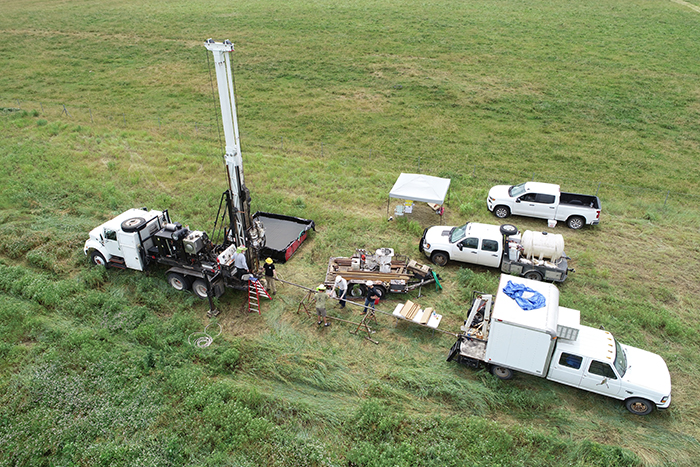
Figure 2--Diagram depicting the collection of drill core with a coring bit and inner tube. Note the pressurized fluid injection and circulation of cuttings to the surface
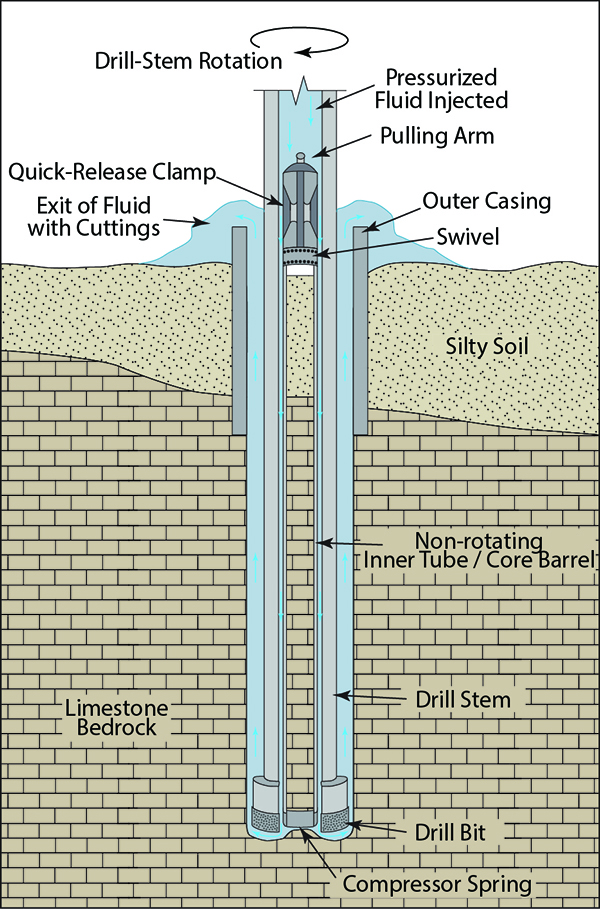
For the recovery of cylindrical core samples, drillers use an inner tube. Inner tubes - also referred to as core barrels - are dropped down the inside of the drill stem when the drill stem is at rest (that is, not rotating). Once the inner tube is inserted into the drill stem, a clamp locks the inner tube into place and drilling continues. A ball-bearing assembly (swivel) prevents unwanted rotation of the inner tube while the rotating drill stem cuts downward into the bedrock. Once the inner tube is full of core, a "fishing line," which is a heavy gauge wire with a grapple on its end, is dropped down the interior of the drill stem in preparation for hoisting the inner tube to the surface. The fishing line attaches to a special knob, called a pulling arm, at the top of the inner tube. As drillers remove the slack in the fishing line and pull upward on the arm, the inner tube clamps are disengaged, allowing the tube to be pulled to the surface. A compressor spring (called a "core catcher") installed at the base of the inner tube prevents the cylindrical core from falling out of the tube as it is hoisted. Core is then removed from the inner tube and placed in storage containers, and the process is repeated until the desired depth is reached. To prevent groundwater contamination and collapse of the drill hole by soil or rock at the surface, an outer casing is driven or drilled into the ground to a desired depth early in the drilling process. Cored wells are put into service - as an oil or gas well, a monitoring well, or an injection well for non-potable wastewater - or are plugged according to appropriate regulations.
The KGS Drill Core Library archives approximately 69,000 boxes of drill core from 5,453 wells in Kansas (fig. 3). When drill cores are removed from the ground, they are placed within specially designed core boxes, annotated with depth markings, and tightly packed to prevent movement of the core. In some cases, drill core may be cut or slabbed and then polished so geologists can better evaluate the rock (fig. 4). The cut core is separated into two sides: the slab side and the butt. The slab side is preserved and archived. Destructive sampling and testing are not allowed on that side. "Butts" refer to whole core or the side of core on which testing can be conducted. The drill cores are given a Kansas unique well ID (KID), an American Petroleum Institute (API) number (unique numbers assigned to oil and gas wells across the United States), or both. The KGS Drill Core Library preserves drill cores at its Lawrence core facility. KGS online databases store detailed information for each core, including well location, depths, operator(s), well type, status, field, and more.
Figure 3--Locations of wells for which cuttings (blue dots) and drill cores (red dots) are available at the KGS.
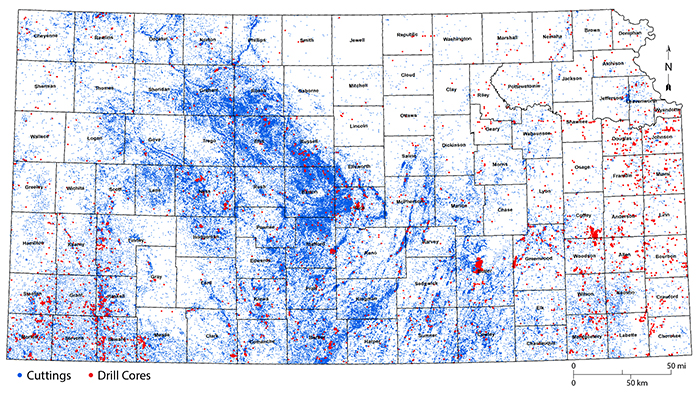
Figure 4--At left, an example of a drill core that has been cut (slabbed) and polished. At right, the KGS Drill Core Library's core storage facility.
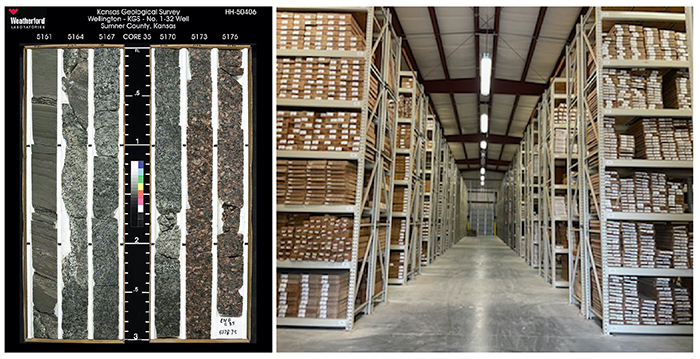
The State of Kansas mandates that cuttings be collected and maintained by the KGS. The KGS Kansas Geologic Sample Repository in Wichita maintains cuttings samples for more than 147,000 wells in Kansas (fig. 3). This represents approximately one-third of all wells that have been drilled in Kansas. Cuttings are collected at the drill rig from a mud slurry that is brought to the surface via drilling fluids during the drilling process and require additional processing before storage. At the well site, the samples are washed by hand, then allowed to dry. The samples are then bagged and delivered to the Kansas Geologic Sample Repository, where they are packaged, boxed, and stored for future reference and testing (fig. 5). As with drill cores, cuttings are assigned a KID or API number or both and are linked on the Kansas Oil and Gas interactive web map to a database that contains all available information pertaining to the well from which they were collected.
Figure 5--At left, cuttings being bagged as part of the sample curation process at the Kansas Geologic Sample Repository in Wichita. Center, one of several cuttings storage facilities in Wichita. At right, cuttings from a well in Elk County, Kansas.
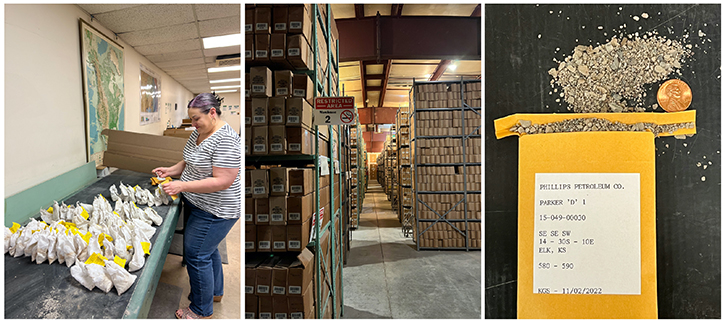
Core and cuttings are the primary materials available to scientists to obtain an understanding of how minerals and water are distributed underground. The process of drilling is incredibly expensive. Each deep well can cost more than $1 million in 2022 dollars, and coring is an expensive add-on to most well drilling. A conservative estimate of the replacement cost for the samples archived by the KGS is $147 billion (147,000 wells x $1 million per well). By keeping a repository of these materials, the KGS is reducing the cost of development of the state's water and mineral resources as well as keeping an archive of the geological past so future geologists with new ideas and new theories can test them in the least expensive way possible.
Drill cores, cuttings, and associated data can be identified using the KGS Drill Core Library Index database (https://www.kgs.ku.edu/Magellan/CoreLibrary/index.html) and the Rotary-Cuttings Sample database (https://www.kgs.ku.edu/Magellan/Cuttings/index.html) (fig. 6). These collections are indexed using the Public Land Survey System (section, township, and range), counties, well names and numbers, as well as KID and API numbers. Searches for drill cores or cuttings can be conducted using any of these attributes. The public may request access to cuttings and drill cores for nominal fees, and additional services such as photographing and sampling the rocks for research may be accommodated. The Kansas Oil and Gas interactive web map (https://maps.kgs.ku.edu/oilgas/index.html) allows users to search for wells for which core or cuttings are available.
Figure 6--At top, search options for the KGS Oil and Gas Database (https://www.kgs.ku.edu/PRS/petroDB.html). Access to the Core Library Index and Rotary-Cuttings Samples collections are outlined in red. At bottom, Core Library Index search engine, which permits the user to retrieve results by numerous well criteria, such as section, county, or API number.
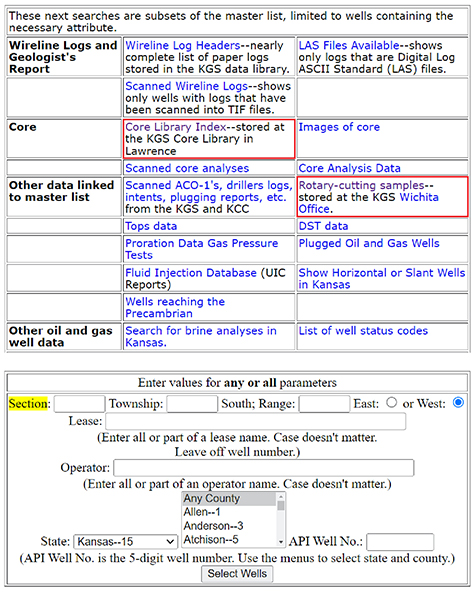
This material is based upon work supported by the U.S. Geological Survey under Grant No. G21AP10466-00. The views and conclusions contained in this document are those of the authors and should not be interpreted as representing the opinions or policies of the U.S. Geological Survey. Mention of trade names or commercial products does not constitute their endorsement by the U.S. Geological Survey.
KGS Drill Core Library
(785) 864-2098
Email: kgs-webadmin@ku.edu
1930 Constant Ave.
Lawrence, KS 66047
Core examination and sampling must be carried out at KGS facilities.
Kansas Geologic Sample Repository
(316) 943-2343
Email: kgsr@ku.edu
4150 W. Monroe St.
Wichita, KS 67209
Hours
Hours at both the KGS Drill Core Library and the Kansas Geologic Sample Repository are 8 a.m.-noon and 1-5 p.m. Monday to Friday, except state and federal holidays.
Kansas Geological Survey, Public Outreach
Comments to kgs-webadmin@ku.edu
Web version February 24, 2023
http://www.kgs.ku.edu/Publications/PIC/pic39.html